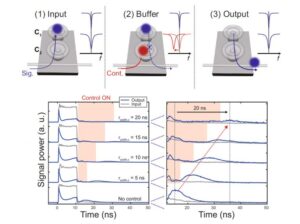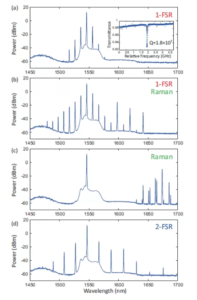Behavior of optical carcoms under mode coupling by backscattered light
Research
Behavior of optical carcoms under mode coupling by backscattered light
Important Guideline for the Practical Application of Optical Carcom Light Sources
Optical carcombs (microcombs) are generated via third-order nonlinear processes by inputting low-power continuous light into a micro optical resonator, and have recently attracted attention as a new light source. Monochromatic light at the entrance is converted into "multi-colored light" with guaranteed uniformity on the frequency axis as it exits the resonator, and these are expected to be used not only as a measure (standard) of light, but also for various applications.
In this study, we approached the problem of how backscattered light caused by small particles or structural defects attached to the resonator affects the generation of optical carcoms from the viewpoint of both numerical simulation and experiment. It is known that light propagating in opposite directions forms a "mode coupling state," and the stronger the coupling, the more difficult it is to generate mode-synchronized high-quality optical CURCOMs. The experimental results shown in Figure 1 indicate that the coupling strength of each longitudinal mode is closely related to the strength of the optical Kercomb in the pump direction [Figure 1(a)] and the strength of the backscattered optical Kercomb [Figure 1(b)]. Unexpected particle adhesion may occur when the material is used as a real product, not in a clean environment such as a university laboratory. Considering such problems, the results and guidelines presented in this study are expected to be of great value for the application of optical carcoms.

Figure 1: (a) Optical Kercomb spectrum in the pump direction. (b) Backscattered optical Kercomb spectrum. (c) Transmission spectra of mode-coupled resonance wavelengths. (d) Intensity ratio of optical Kercombs propagating in opposite directions to each longitudinal mode vs. coupling strength.
- Categories
- 研究トピックス



